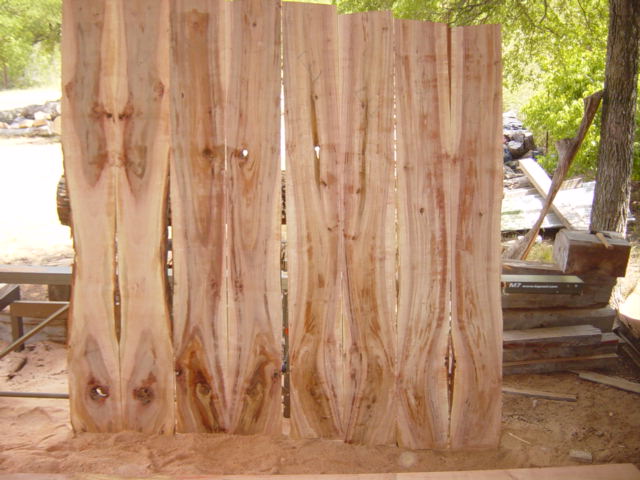Question
I have just sawn five large willow trees (central Texas) and loaded them in my solar kiln. Total of about 350bf and mostly 4/4, but I did put six 8/4 flitches on the bottom. How fast can I dry this? The kiln is an attic collector, the box is 8' x 20' x 7' high, the collector roof is 10' x 20'. Should I cover part of the collector? It has been over 105º every day for almost a week now. Below is a picture of six bookmatched 12" x 8' 4/4.

Forum Responses
(Sawing and Drying Forum)
From Professor Gene Wengert, forum technical advisor:
I would dry willow like oak and this means, among other things, that for 4/4 you should have 10 BF for every 1 sq ft. So you have too much collector... enough for 2000 BF of 4/4. For 8/4 we need about 25 BF per 1 sq ft. Mixing thicknesses in the same kiln load is not a good compromise. It would be better to consider air drying under roof for one or the other, especially in a warm sunny climate. City trees are especially hard to dry.
Although the article from Purdue states that willow can be dried with a "severe" schedule, that conclusion was based on uses for willow in the 1950s. Such uses were not quality uses, so collapse and honeycomb were not considered defects. (We see the same for alder and aspen and a few other species.) I suspect that the questioner is interested in producing a quality lumber product, perhaps for furniture or cabinets. Hence, the best drying approach in a solar kiln (and perhaps any kiln) is one that is similar to oak. This would also be the best approach to material with knots and so on. The old schedules were based primarily on upper grades of material, large logs, etc.
To the original questioner: You state that it has been over 105 F. I assume you mean this is the outside air temperature. A temperature inside a solar kiln of 105 is okay if the humidity is not too low. But in a kiln of your size, if it is well insulated, it would not be unusual to see the inside kiln temperatures to be 35 F hotter than outside (or more), giving you 140 F peak in the kiln, which is too hot.